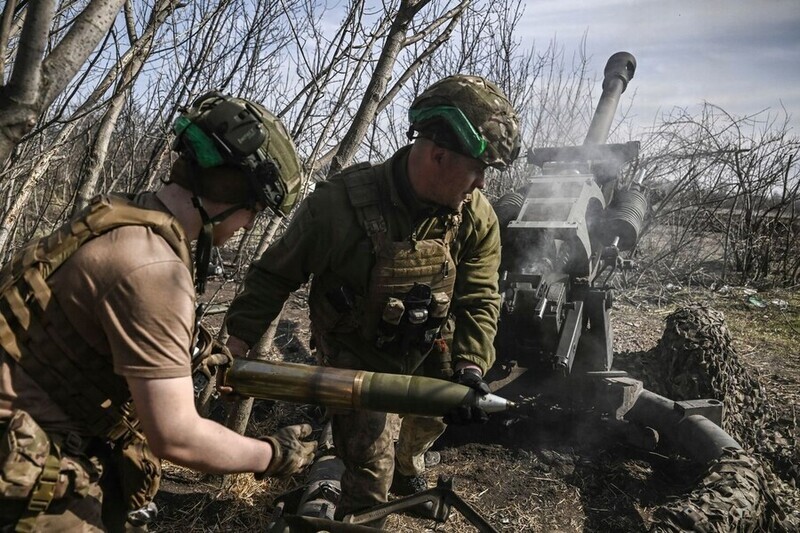hankyoreh
Links to other country sites 다른 나라 사이트 링크
Seoul appears to have discussed loophole for supplying lethal aid to Ukraine

On numerous occasions, the South Korean government has stated the official position that it is willing to provide Ukraine with humanitarian aid and non-lethal military goods, but not with lethal weapons.
But details that emerged Saturday in reports on US intelligence agencies’ interception of South Korean government discussions regarding weapon support to Ukraine suggest that Seoul gave considerable thought to the question of whether to provide assistance with lethal weapons.
According to US news reports, the South Korean government internally discussed the possibility of an indirect arrangement where the US would give Ukraine artillery shells provided by South Korea. Seoul also expressed concerns that US President Joe Biden might pressure South Korean President Yoon Suk-yeol to supply munitions.
Since the war in Ukraine began in February 2022, the South Korean government has consistently maintained that it would not provide lethal weapon aid.
In an April 2022 telephone conversation between the South Korean and Ukrainian defense ministers held before the Yoon administration took office, Ukraine’s Oleksii Reznikov asked South Korea to provide assistance with anti-aircraft weapon systems for shooting down helicopters and aircraft.
Suh Wook, South Korea’s minister of national defense at the time, refused the request, insisting it would not be possible in light of the need to maintain a readiness posture against threats posed by North Korea.
Last October, Yoon responded to remarks from Russian President Vladimir Putin about the risk of South Korea-Russia relations breaking down if South Korea provided weapons to Ukraine.
“We\'ve provided humanitarian and peaceful assistance to Ukraine in solidarity with the international community but never lethal weapons or any such thing,” Yoon said at the time.
Despite that message, there has been ongoing speculation that the South Korean government might be providing weapons to Ukraine through indirect means.
In November, the Ministry of National Defense announced that it was in discussions with the US on the exportation of 155mm shells, which it said was meant to make up for the shortfall in the US stockpiles of shells due to the support it was providing to Ukraine.
The ministry stressed that there had been no change in the government’s policy and that it would “provide shells on the understanding that the US is to be the end user.”
But some analysts suggested this was intended as a means of indirect aid — and that the shells exported to the US were essentially ending up in Ukraine.
Commenting on a New York Times report Sunday on circumstantial evidence that the US Central Intelligence Agency (CIA) eavesdropped on South Korea’s and other allies’ discussions on lethal weapons aid to Ukraine, a key official with the South Korean presidential office reiterated, “There has been no change in the government’s basic position [of not providing lethal weapon assistance].”
Meanwhile, Ukraine itself and NATO have continued to request South Korean weapon aid to Ukraine. In a press conference held on the war’s one-year anniversary last February, Ukrainian President Volodymyr Zelenskyy expressed his hope that South Korea would provide weapon assistance.
NATO Secretary General Jens Stoltenberg, who also requested direct lethal weapon assistance during a South Korea visit in January, shared related remarks in a press conference after a foreign ministers’ meeting attended by South Korea and others on April 5.
“[T]he fact that they are now delivering more and producing more to replenish the stocks on NATO Allies enable[s] us [NATO members] to continue to deliver to Ukraine,” he said at the time.
Last year, South Korea provided Ukraine with non-lethal military items such as gas masks, bulletproof vests, tents, blankets, combat rations, and medications. This did not include lethal weapons that could be used directly in combat with Russia, such as ammunition, firearms, or missiles.
This year, Seoul decided to provide US$130 million worth of additional aid primarily for humanitarian purposes with a focus on reconstruction for the benefit of the Ukrainian public. This includes efforts to clear mines and restore power grids, along with ambulances, medical equipment, and infrastructure building.
By Jang Ye-ji, staff reporter
Please direct questions or comments to [english@hani.co.kr]

Editorial・opinion
![[Column] Will Seoul’s ties with Moscow really recover on their own? [Column] Will Seoul’s ties with Moscow really recover on their own?](https://flexible.img.hani.co.kr/flexible/normal/500/300/imgdb/original/2024/0513/5917155871573919.jpg) [Column] Will Seoul’s ties with Moscow really recover on their own?
[Column] Will Seoul’s ties with Moscow really recover on their own?![[Column] Samsung’s ‘lost decade’ and Lee Jae-yong’s mismatched chopsticks [Column] Samsung’s ‘lost decade’ and Lee Jae-yong’s mismatched chopsticks](https://flexible.img.hani.co.kr/flexible/normal/500/300/imgdb/original/2024/0512/3017154788490114.jpg) [Column] Samsung’s ‘lost decade’ and Lee Jae-yong’s mismatched chopsticks
[Column] Samsung’s ‘lost decade’ and Lee Jae-yong’s mismatched chopsticks- [Correspondent’s column] The real reason the US is worried about Chinese ‘overcapacity’
- [Editorial] Yoon’s gesture at communication only highlights his reluctance to change
- [Editorial] Perilous stakes of Trump’s rhetoric around US troop pullout from Korea
- [Guest essay] Preventing Korean Peninsula from becoming front line of new cold war
- [Column] The state is back — but is it in business?
- [Column] Life on our Trisolaris
- [Editorial] Penalties for airing allegations against Korea’s first lady endanger free press
- [Editorial] Yoon must halt procurement of SM-3 interceptor missiles
Most viewed articles
- 1Seoul’s plan to adopt SM-3 missiles is like wanting a sledgehammer to catch a fly
- 2[Column] Samsung’s ‘lost decade’ and Lee Jae-yong’s mismatched chopsticks
- 3[Correspondent’s column] The real reason the US is worried about Chinese ‘overcapacity’
- 4Korea poised to overtake Taiwan as world’s No. 2 chip producer by 2032
- 560% of young Koreans see no need to have kids after marriage
- 6[Editorial] Yoon’s gesture at communication only highlights his reluctance to change
- 7Yoon voices ‘trust’ in Japanese counterpart, says alliance with US won’t change
- 8Yoon rejects calls for special counsel probes into Marine’s death, first lady in long-awaited presse
- 9S.K.-Japan joint history project to be revived
- 10Former President Roh Tae-woo, mastermind of 1979 military coup, dies at 88